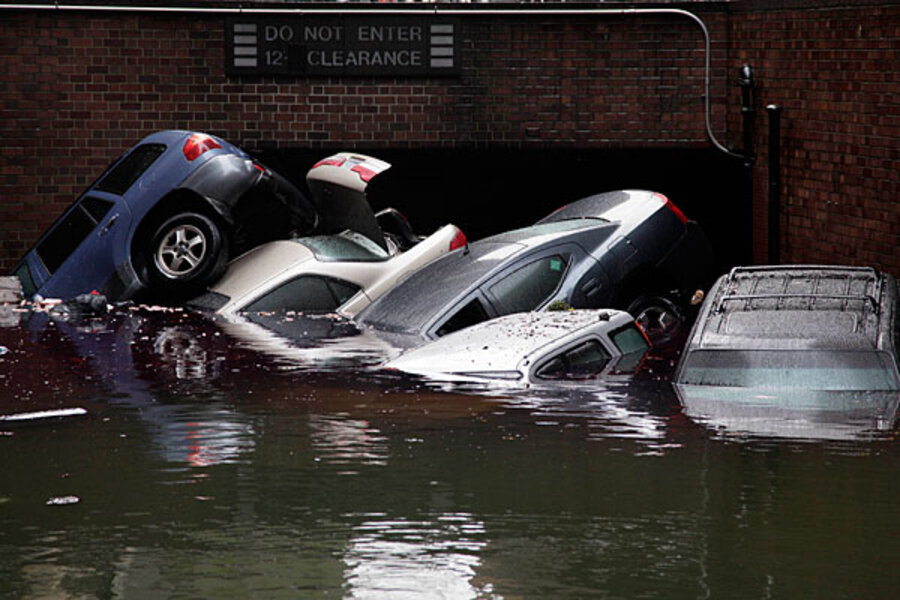New York reels from hurricane Sandy: 'Unprecedented ... is what we got.'
Loading...
| New York
As much as it has captivated the nation, the crane left dangling high over Manhattan’s 57th Street by hurricane Sandy’s destructive winds likely is the least of the city’s problems.
A day after Sandy battered the region with powerful winds and a historic storm surge, New York faces the challenges of getting its flooded mass transit system, which carries about 7 million passengers each day, back up and running and restoring electricity to the significant portion of the city left in the dark.
Officials are also still assessing the damage done to La Guardia Airport, which suffered extensive damage from waves breaking over its runway.
“We expected an unprecedented storm and that is what we got,” said Mayor Michael Bloomberg at a press conference Tuesday morning. “The damage is extensive and will not be repaired overnight.”
As of Tuesday morning, Mr. Bloomberg said 750,000 New York City residents were without electricity. To prevent damage to its steam system, which provides heat and hot water to many buildings, Con Edison shut that system down in advance. That, too, needed to be restarted.
“Power may be out in some places for two or three days or maybe longer,” said Bloomberg.
The mayor might be overly optimistic. Con Edison uses the subway tunnels for many of its cables and some of those tunnels are now filled with salt water. The worst damage was in lower Manhattan, where, as a result of the storm surge, the Hudson River topped its banks on one side of the island and the East River on the other.
“When you fill a subway tunnel loaded with electrical cables with salt water, that is a bad combination,” Gov. Andrew Cuomo said in a press briefing.
The water filling the tunnels also meant that the subways might be out for some time. Officials said some stations had water all the way to their ceilings.
“This is the most devastating thing we’ve ever had happen,” said Joseph Lhota, the chairman and chief executive officer of the Metropolitan Transportation Authority at a press briefing.
One indication of the challenges facing the MTA: a 40-foot powerboat was washed across the railroad tracks that bring commuters into New York.
In fact through Tuesday, Amtrak, which connects with Boston and Washington, still had no train service in or out of New York City.
The only bright spot for mass transit was the bus system. The city’s buses were moved to high ground before the height of the storm and did not suffer any losses. Limited bus service was expected to resume Tuesday evening with full service on Wednesday.
The city’s subway cars were also moved in advance to secure locations, so once the tunnels are safe for passengers, service can begin again.
The city school system, with its 1 million students, will remain closed on Wednesday.
The subways were not the only transportation links where salt water presented a problem. The storm surge sent water gushing into the Holland and Brooklyn Battery tunnels. Both remained closed Tuesday.
To try to help the city move water, a US Army pumping team was headed for the city.
“We need them very badly,” Governor Cuomo said.
In fact, the city, much like other stricken parts of the region, was counting on repairmen from around the country. According to Sen. Chuck Schumer, also at the press briefing, some 200 electric utility repairmen were arriving from California. In addition, Caterpillar was shipping 200 generators to the city.
Despite the lack of electricity downtown, both the New York Stock Exchange and the Nasdaq planned on opening Wednesday. Most of their trading was expected to be conducted off-site or on computers since it could still be difficult for stock traders to get downtown.
Many of the traders live in New Jersey or on Long Island, where conditions could be even more challenging. According to Cuomo, 90 percent of the homes that use the Long Island Power Authority were without electricity. That is likely to continue for several more days until the winds calm down. On Tuesday afternoon the area was still getting wind gusts of 50 miles per hour.
The situation was equally as bad for New Jersey, where 2.4 million residents did not have power. After hurricane Irene last year, 1.2 million people lost their power.
Restoration of power could take as long as eight days, Gov. Chris Christie estimated at a press briefing Tuesday morning. “Full restoration may take longer,” said the governor, who noted that crews were arriving from Indiana, Texas, and even Canada to try to restring electrical lines.
However, fixing the electrical system will entail more than just putting lines back up. On Monday night, residents watched as substations around the tri-state area exploded in bright flashes of light. An explosion at a Con Edison substation on the Lower East Side made the national news.
City investigators will also be out at Breezy Point in Queens, where a wind-driven fire jumped from house to house. Bloomberg said it appeared 80 homes had been destroyed in the blaze. Although many people had evacuated the area, it was not clear if there were any fatalities.
“We are hoping and praying there was no loss of life,” Bloomberg said.
As for that crane that was dangling over 57th Street, the mayor said it would be secured to the side of the building once the wind moderated. Then, engineers would have to devise a way to safely remove it and lower it to the ground.







